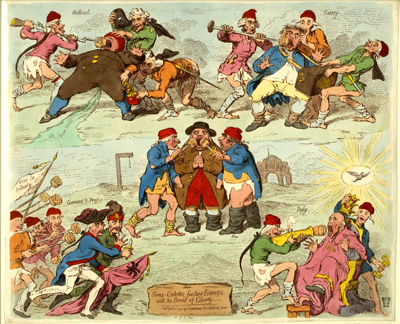Sans-Culottes Feeding Europe with the Bread of Liberty
On December 15 1792, the members of the ruling body of France, the Assemblee Nationale, published a rather extraordinary document, the Decree for Proclaiming the Liberty and Sovereignty of all Peoples. There they announced that in
the countries which are or shall be occupied by the armies of the Republic, the generals shall proclaim immediately, in the name of the French nation, the sovereignty of the people, the suppression of all the established authorities and of the existing taxes, the abolition of the tithe, of feudalism, of seignioral rights, both feudal and censuel, fixed or precarious. . . .
They then went on to say that the occupying generals would assure the people that they were bringing them "peace, assistance, fraternity, liberty and equality."
If anyone had been naive enough to believe that what happened in France would stay in France, this proclamation was a wake-up call. The world was on notice that France intended to be the chief propagator of liberty.

© Trustees of the British Museum
But though this much of the decree must have sounded good, there was, in effect, some fine print in other articles of the decree that made it less attractive. In article ten, for instance, it is noted that there "shall be a list of the expenses which the French Republic shall have incurred for the common defence" and that would be duly paid by the liberated country. And finally, in article eleven, the
French nation declares that it will treat as enemies the people who, refusing liberty and equality, or renouncing them, may wish to preserve, recall, or treat with the prince and the privileged castes; it promises and engages not to subscribe to any treaty, and not to lay down its arms until after the establishment of the sovereignty and independence of the people whose territory the troops of the Republic have entered upon and who shall have adopted the principles of equality, and established a free and popular government.
As Edmund Burke noted about two weeks later in the course of his famous "dagger speech" on the Aliens Bill:
The system of fraternizing" decreed by the National Convention was "to be propagated by the sword, and if any nation wished to adhere to its old maxims, these regenerators were to cram this fraternity down their throats, and to force them to swallow the dose, however nauseous it might be to them.
Gillray had borrowed from Burke's speech for his print, The Dagger Scene, or the Plot Discover'd less than two weeks earlier. So it's likely that he would have remembered this striking image of force feeding when creating a graphic response to the French decree.
In each country represented by Gillray's print, the revolutionary sans-culottes, identified by their bonnets rouges and absence of breeches (culottes) cram the bread of liberty down the unwilling throats of that country's representative. And in each case, as noted in article ten of the decree, there is a price to pay. In Holland, a sans-culotte drains the gold from the Dutchman's pockets; in Savoy a revolutionary confiscates the Savoyard's hurdy-gurdy; in Germany and Prussia, members of military are chased from their lands; and finally in Italy, a sans-culotte with a blunderbuss literally steps on the toes of the Pope while another of his compatriots removes the papal keys and tiara.
In addition to being identified in text on the print, Gillray uses national stereotypes to symbolize each country as he did in The Dutchman in the Dumps. The Dutchman is portly, and has the Hollander's distinctive hat and pipe. Savoy is symbolized by the hurdy gurdy which was considered to be the savoyard's typical instrument and source of income. The Prussians and Germans are symbolized by their military with the Hapsburg eagle on the banner held by one soldier, and the cap with the Death's head Hussar worn by the other soldier. Catholic Italy, of course, is represented by the Pope with his keys and tiara, and the dove-like Holy Spirit who seems to be making a quick departure. And finally, England itself is represented by John Bull whose pockets are being picked by Gillray's two favorite revolutionaries, Charles James Fox and Richard Brinsley Sheridan while behind them is London's Temple Bar and Tyburn's gallows.
As usual, Gillray has turned a single image into a wonderful varied composition. Every scene is different, every figure is active and naturally disposed, and the whole is wonderfully balanced and integrated.
Sources and Reading
- Commentary from the British Museum on Sans-culottes Feeding Europe with the Bread of Liberty
- "Decree for Proclaiming the Liberty and Sovereignty of all Peoples. December 15, 1792,"
- Thomas Wright and R.H. Evans, Historical and Descriptive Account of the Caricatures of James Gillray #95
Comments & Corrections
NOTE: Comments and/or corrections are always appreciated. To make that easier, I have included a form below that you can use. I promise never to share any of the info provided without your express permission.